Properties of Cirrus Cloud Observed over Koror, Palau (7.3°N, 134.5°E), in Tropical Western Pacific Region
Abstract
:1. Introduction
2. Site and Methods
2.1. Site: The Palau Atmospheric Observatory (PAO)
2.2. Instruments
2.2.1. Lidar System
2.2.2. Ozonesonde and Radiosonde
2.3. Method
2.3.1. Retrieval of Properties of Cirrus Cloud
2.3.2. Detection of the Cirrus Cloud Layer from Lidar
- Before applying the scheme, a pre-screening based on the lidar profile in PC mode is performed to avoid profiles that may have problems like dead time, electronic noise, and background illumination effects [47]. In this study, only the lidar profile in PC mode with an acceptable signal-to-noise ratio (>3.0) in 10–20 km is further analyzed and included in the final dataset products of ComCAL.
- The assumption of LR in the particle layer poses a challenge in real-world scenarios where LR varies vertically due to factors like aerosol particle size, refractive index, and shape. For example, LR can range from approximately 20 sr in the lower troposphere with marine aerosols to 100 sr when combustion aerosol particles are present at higher altitudes [54,55]. In our study, only cirrus cloud layers are considered. Thus, to avoid errors introduced by the assumption of , cirrus layers with unexpectedly high (>50) were screened out.
- The effect of the multiple scattering (MS) is considered depending on the telescope field of view (FOV) of the lidar, the COD, and the altitude of the cloud. The higher the cloud, the thicker are laser beam and FOV, so it becomes easier for the photons to stay in the beam or FOV even after scattering. Different methods have been introduced to correct the MS (e.g., Hogan [56] and Eloranta [57]). Since no clear and straightforward method can be used to correct for MS to date, but only adaptions of single scattering to MS, we made tests to ensure that the uncertainty below 9% for COD value less than 2, as can be seen in details in Appendix C. Based on the sensitivity analysis, the cases of the cirrus cloud layer with COD higher than 2 were screened out to control the effect of MS on the quality of the retrieved properties.
3. Results
3.1. Cirrus Occurrence over Palau
3.2. Geometrical and Thermodynamic Properties
3.3. Optical Properties
3.4. Cloud Layer and the Tropopause
3.5. Comparison of the Cirrus Cloud Properties in Different Tropical Sites
4. Discussion
5. Conclusions
Author Contributions
Funding
Data Availability Statement
Acknowledgments
Conflicts of Interest
Appendix A. Measurement Hours of the Lidar System

Appendix B. Example of WCT Method Applied to Two Layers of Cirrus Clouds
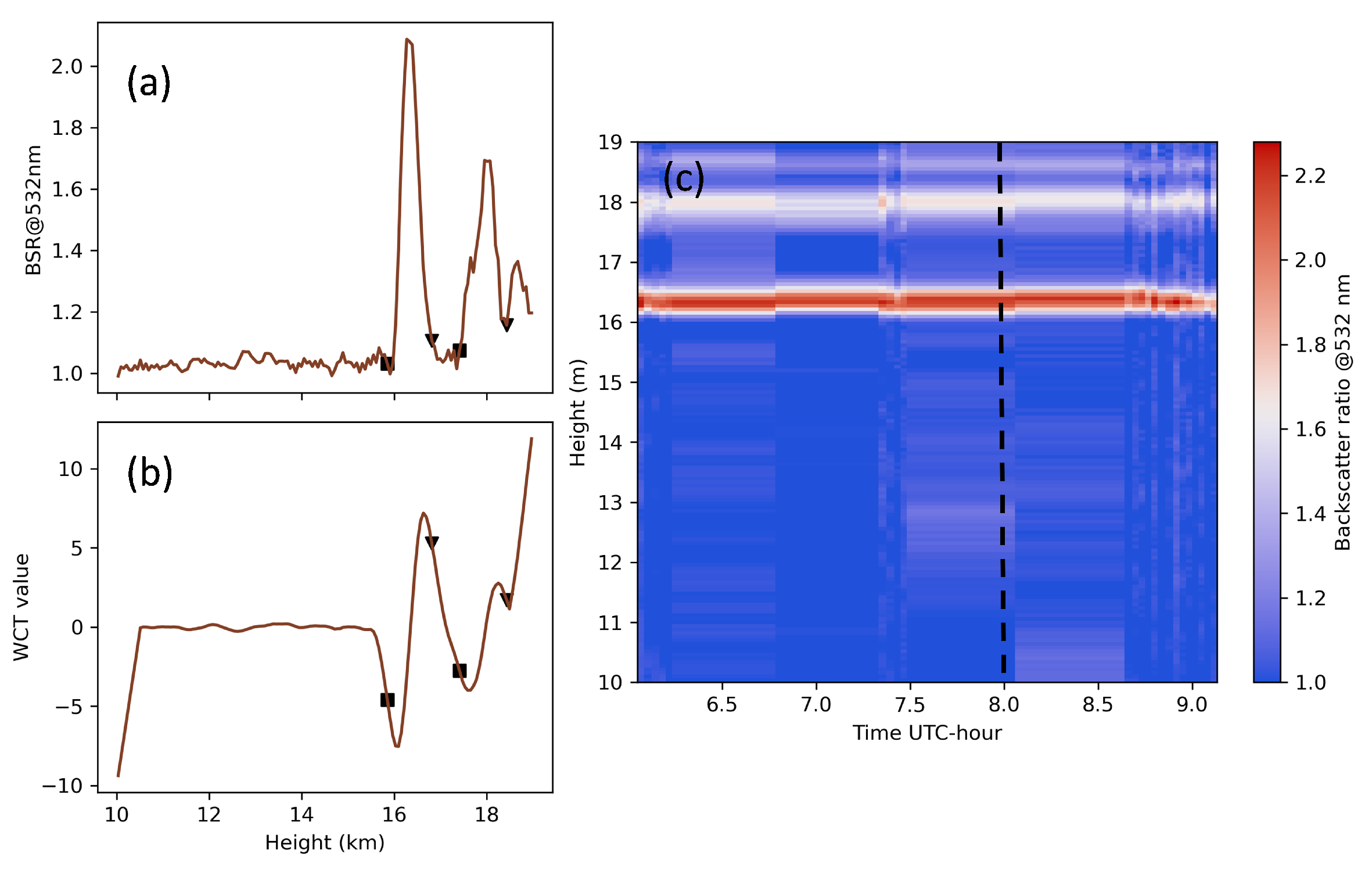
Appendix C. Sensitivity Study for the Multiple Scattering Effect

Appendix D. The TTL Features over Palau
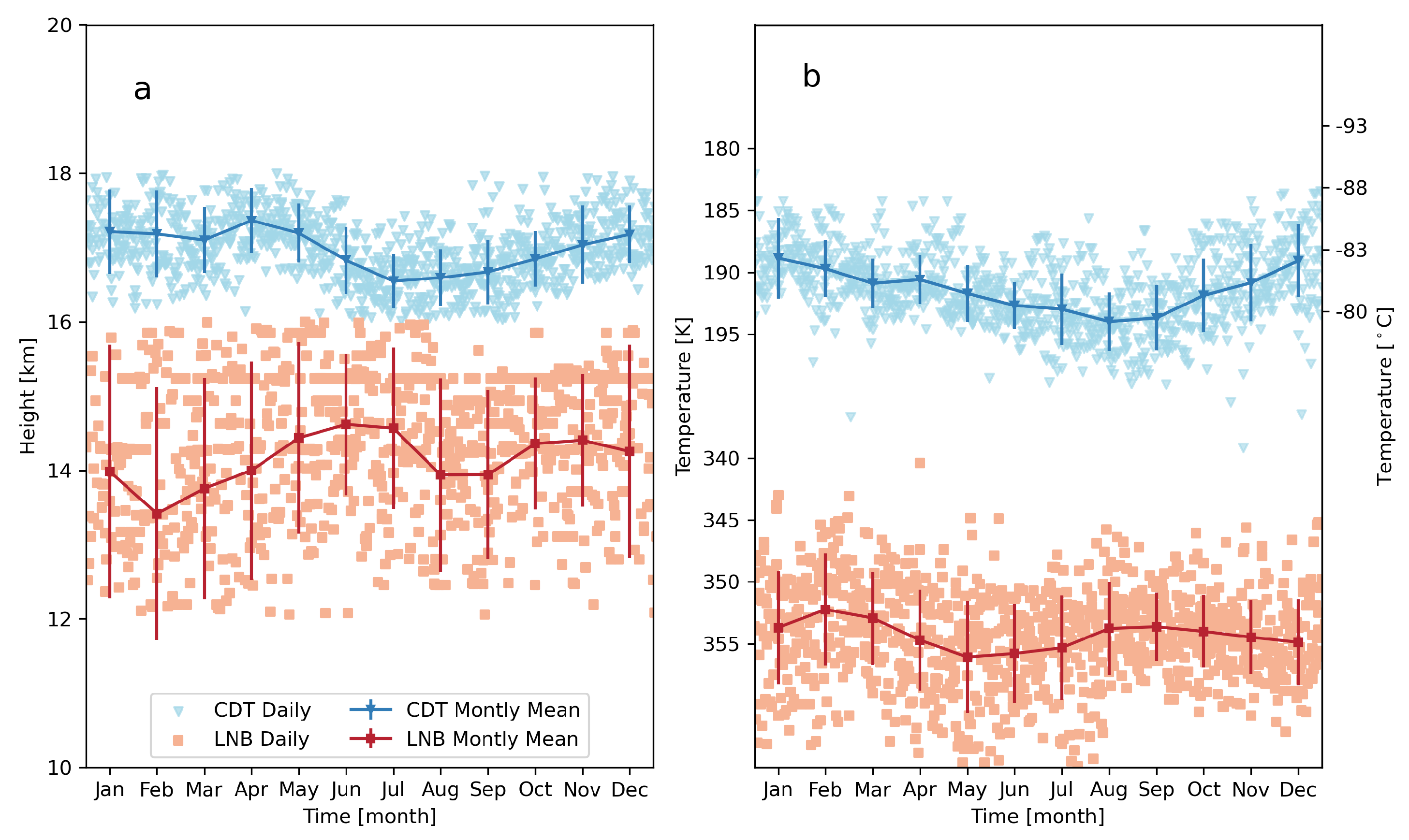
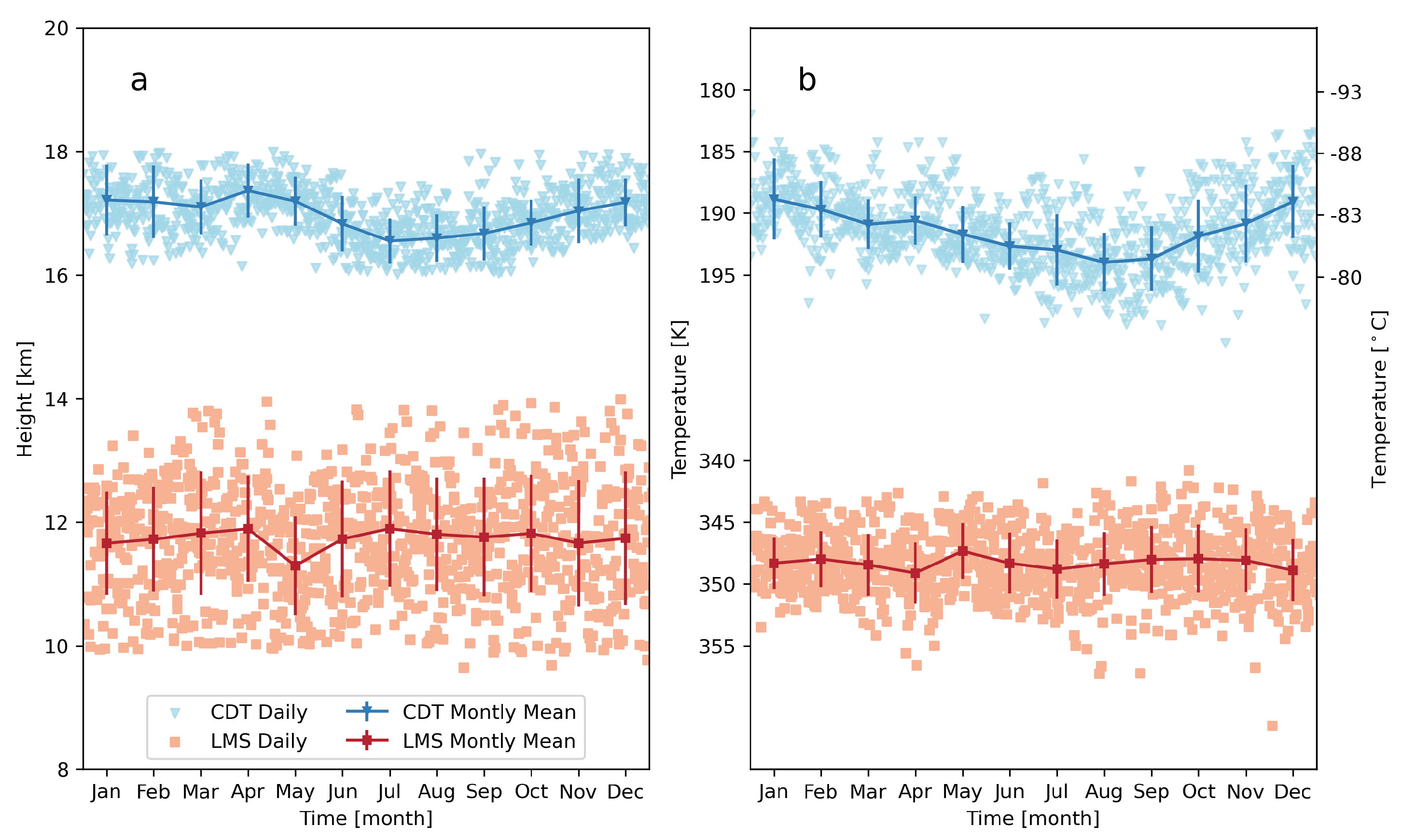
References
- Sassen, K.; Wang, Z.; Liu, D. Global distribution of cirrus clouds from CloudSat/Cloud-Aerosol lidar and infrared pathfinder satellite observations (CALIPSO) measurements. J. Geophys. Res. Atmos. 2008, 113. [Google Scholar] [CrossRef]
- Sassen, K.; Wang, Z.; Liu, D. Cirrus clouds and deep convection in the tropics: Insights from CALIPSO and CloudSat. J. Geophys. Res. Atmos. 2009, 114. [Google Scholar] [CrossRef]
- Liou, K.N. Influence of Cirrus Clouds on Weather and Climate Processes: A Global Perspective. Mon. Weather. Rev. 1986, 114, 1167–1199. [Google Scholar] [CrossRef]
- Burkhardt, U.; Kärcher, B. Global radiative forcing from contrail cirrus. Nat. Clim. Change 2011, 1, 54–58. [Google Scholar] [CrossRef]
- Haladay, T.; Stephens, G. Characteristics of tropical thin cirrus clouds deduced from joint CloudSat and CALIPSO observations. J. Geophys. Res. Atmos. 2009, 114. [Google Scholar] [CrossRef]
- Zhou, C.; Dessler, A.E.; Zelinka, M.D.; Yang, P.; Wang, T. Cirrus feedback on interannual climate fluctuations. Geophys. Res. Lett. 2014, 41, 9166–9173. [Google Scholar] [CrossRef]
- Fueglistaler, S.; Wernli, H.; Peter, T. Tropical troposphere-to-stratosphere transport inferred from trajectory calculations. J. Geophys. Res. Atmos. 2004, 109. [Google Scholar] [CrossRef]
- Fueglistaler, S.; Dessler, A.E.; Dunkerton, T.J.; Folkins, I.; Fu, Q.; Mote, P.W. Tropical tropopause layer. Rev. Geophys. 2009, 47. [Google Scholar] [CrossRef]
- Immler, F.; Krüger, K.; Tegtmeier, S.; Fujiwara, M.; Fortuin, P.; Verver, G.; Schrems, O. Cirrus clouds, humidity, and dehydration in the tropical tropopause layer observed at Paramaribo, Suriname (5.8°N, 55.2°W). J. Geophys. Res. Atmos. 2007, 112. [Google Scholar] [CrossRef]
- Fu, Q.; Smith, M.; Yang, Q. The Impact of Cloud Radiative Effects on the Tropical Tropopause Layer Temperatures. Atmosphere 2018, 9, 377. [Google Scholar] [CrossRef]
- Lynch, D.K. Cirrus: History and Definitions. In Cirrus; Oxford University Press: Oxford, UK, 2002; pp. 11–40. [Google Scholar]
- Immler, F.; Krüger, K.; Fujiwara, M.; Verver, G.; Rex, M.; Schrems, O. Correlation between equatorial Kelvin waves and the occurrence of extremely thin ice clouds at the tropical tropopause. Atmos. Chem. Phys. 2008, 8, 4019–4026. [Google Scholar] [CrossRef]
- Jensen, E.J.; Thornberry, T.D.; Rollins, A.W.; Ueyama, R.; Pfister, L.; Bui, T.; Diskin, G.S.; DiGangi, J.P.; Hintsa, E.; Gao, R.S.; et al. Physical processes controlling the spatial distributions of relative humidity in the tropical tropopause layer over the Pacific. J. Geophys. Res. Atmos. 2017, 122, 6094–6107. [Google Scholar] [CrossRef]
- DeMott, P. Cirrus: Laboratory Studies of Cirrus Cloud Processes; Oxford University Press: Oxford, UK, 2002; pp. 102–135. [Google Scholar]
- Krämer, M.; Rolf, C.; Luebke, A.; Afchine, A.; Spelten, N.; Costa, A.; Meyer, J.; Zöger, M.; Smith, J.; Herman, R.L.; et al. A microphysics guide to cirrus clouds – Part 1: Cirrus types. Atmos. Chem. Phys. 2016, 16, 3463–3483. [Google Scholar] [CrossRef]
- Pfister, L.; Selkirk, H.B.; Jensen, E.J.; Schoeberl, M.R.; Toon, O.B.; Browell, E.V.; Grant, W.B.; Gary, B.; Mahoney, M.J.; Bui, T.V.; et al. Aircraft observations of thin cirrus clouds near the tropical tropopause. J. Geophys. Res. Atmos. 2001, 106, 9765–9786. [Google Scholar] [CrossRef]
- Comstock, J.M.; Jakob, C. Evaluation of tropical cirrus cloud properties derived from ECMWF model output and ground based measurements over Nauru Island. Geophys. Res. Lett. 2004, 31. [Google Scholar] [CrossRef]
- Waliser, D.E.; Gautier, C. A Satellite-derived Climatology of the ITCZ. J. Clim. 1993, 6, 2162–2174. [Google Scholar] [CrossRef]
- Sun, X.; Palm, M.; Müller, K.; Hachmeister, J.; Notholt, J. Determination of the chemical equator from GEOS-Chem model simulation: A focus on the tropical western Pacific region. Atmos. Chem. Phys. 2023, 23, 7075–7090. [Google Scholar] [CrossRef]
- Holton, J.R.; Gettelman, A. Horizontal transport and the dehydration of the stratosphere. Geophys. Res. Lett. 2001, 28, 2799–2802. [Google Scholar] [CrossRef]
- Jensen, E.J.; Toon, O.B.; Pfister, L.; Selkirk, H.B. Dehydration of the upper troposphere and lower stratosphere by subvisible cirrus clouds near the tropical tropopause. Geophys. Res. Lett. 1996, 23, 825–828. [Google Scholar] [CrossRef]
- Fujiwara, M.; Iwasaki, S.; Shimizu, A.; Inai, Y.; Shiotani, M.; Hasebe, F.; Matsui, I.; Sugimoto, N.; Okamoto, H.; Nishi, N.; et al. Cirrus observations in the tropical tropopause layer over the western Pacific. J. Geophys. Res. Atmos. 2009, 114. [Google Scholar] [CrossRef]
- Jensen, E.J.; Smith, J.B.; Pfister, L.; Pittman, J.V.; Weinstock, E.M.; Sayres, D.S.; Herman, R.L.; Troy, R.F.; Rosenlof, K.; Thompson, T.L.; et al. Ice supersaturations exceeding 100% at the cold tropical tropopause: Implications for cirrus formation and dehydration. Atmos. Chem. Phys. 2005, 5, 851–862. [Google Scholar] [CrossRef]
- Schoeberl, M.R.; Jensen, E.J.; Pfister, L.; Ueyama, R.; Wang, T.; Selkirk, H.; Avery, M.; Thornberry, T.; Dessler, A.E. Water Vapor, Clouds, and Saturation in the Tropical Tropopause Layer. J. Geophys. Res. Atmos. 2019, 124, 3984–4003. [Google Scholar] [CrossRef] [PubMed]
- Sassen, K.; Cho, B.S. Subvisual-Thin Cirrus Lidar Dataset for Satellite Verification and Climatological Research. J. Appl. Meteorol. Climatol. 1992, 31, 1275–1285. [Google Scholar] [CrossRef]
- McFarquhar, G.M.; Heymsfield, A.J.; Spinhirne, J.; Hart, B. Thin and Subvisual Tropopause Tropical Cirrus: Observations and Radiative Impacts. J. Atmos. Sci. 2000, 57, 1841–1853. [Google Scholar] [CrossRef]
- Heymsfield, A.J. Ice Particles Observed in a Cirriform Cloud at −83 °C and Implications for Polar Stratospheric Clouds. J. Atmos. Sci. 1986, 43, 851–855. [Google Scholar] [CrossRef]
- Reverdy, M.; Noel, V.; Chepfer, H.; Legras, B. On the origin of subvisible cirrus clouds in the tropical upper troposphere. Atmos. Chem. Phys. 2012, 12, 12081–12101. [Google Scholar] [CrossRef]
- Holton, J.R.; Haynes, P.H.; McIntyre, M.E.; Douglass, A.R.; Rood, R.B.; Pfister, L. Stratosphere-troposphere exchange. Rev. Geophys. 1995, 33, 403–439. [Google Scholar] [CrossRef]
- Platt, C.M.R.; Scott, S.C.; Dilley, A.C. Remote Sounding of High Clouds. Part VI: Optical Properties of Midlatitude and Tropical Cirrus. J. Atmos. Sci. 1987, 44, 729–747. [Google Scholar] [CrossRef]
- Platt, C.M.R.; Young, S.A.; Manson, P.J.; Patterson, G.R.; Marsden, S.C.; Austin, R.T.; Churnside, J.H. The Optical Properties of Equatorial Cirrus from Observations in the ARM Pilot Radiation Observation Experiment. J. Atmos. Sci. 1998, 55, 1977–1996. [Google Scholar] [CrossRef]
- Sassen, K.; Benson, S. A Midlatitude Cirrus Cloud Climatology from the Facility for Atmospheric Remote Sensing. Part II: Microphysical Properties Derived from Lidar Depolarization. J. Atmos. Sci. 2001, 58, 2103–2112. [Google Scholar] [CrossRef]
- Pace, G.; Cacciani, M.; di Sarra, A.; Fiocco, G.; Fuà, D. Lidar observations of equatorial cirrus clouds at Mahé Seychelles. J. Geophys. Res. Atmos. 2003, 108. [Google Scholar] [CrossRef]
- Das, S.K.; Chiang, C.W.; Nee, J.B. Characteristics of cirrus clouds and its radiative properties based on lidar observation over Chung-Li, Taiwan. Atmos. Res. 2009, 93, 723–735. [Google Scholar] [CrossRef]
- Pandit, A.K.; Gadhavi, H.; Ratnam, M.V.; Jayaraman, A.; Raghunath, K.; Rao, S.V.B. Characteristics of cirrus clouds and tropical tropopause layer: Seasonal variation and long-term trends. J. Atmos. Sol. Terr. Phys. 2014, 121, 248–256. [Google Scholar] [CrossRef]
- Stephens, G.L.; Vane, D.G.; Boain, R.J.; Mace, G.G.; Sassen, K.; Wang, Z.; Illingworth, A.J.; O’Connor, E.J.; Rossow, W.B.; Durden, S.L.; et al. THE CLOUDSAT MISSION AND THE A-TRAIN: A New Dimension of Space-Based Observations of Clouds and Precipitation. Bull. Am. Meteorol. Soc. 2002, 83, 1771–1790. [Google Scholar] [CrossRef]
- Pandit, A.K.; Gadhavi, H.S.; Venkat Ratnam, M.; Raghunath, K.; Rao, S.V.B.; Jayaraman, A. Long-term trend analysis and climatology of tropical cirrus clouds using 16 years of lidar data set over Southern India. Atmos. Chem. Phys. 2015, 15, 13833–13848. [Google Scholar] [CrossRef]
- Cairo, F.; De Muro, M.; Snels, M.; Di Liberto, L.; Bucci, S.; Legras, B.; Kottayil, A.; Scoccione, A.; Ghisu, S. Lidar observations of cirrus clouds in Palau (7°N, 134°E). Atmos. Chem. Phys. 2021, 21, 7947–7961. [Google Scholar] [CrossRef]
- Müller, K.; Tradowsky, J.S.; von der Gathen, P.; Ritter, C.; Patris, S.; Notholt, J.; Rex, M. Measurement report: The Palau Atmospheric Observatory and its ozonesonde record—continuous monitoring of tropospheric composition and dynamics in the tropical western Pacific. Atmos. Chem. Phys. 2024, 24, 2169–2193. [Google Scholar] [CrossRef]
- Müller, K. Characterization of Ozone and the Oxidizing Capacity of the Tropical West Pacific Troposphere. Ph.D. Thesis, Fachbereich Physik und Elektrotechnik der Universität, Bremen, Germany, 2020. [Google Scholar]
- Global Modeling and Assimilation Office (GMAO). MERRA-2 tavgU_2d_ocn_Nx: 2d,diurnal, Time-Averaged, Single-Level, Assimilation, Ocean Surface Diagnostics, V5.12.4; Goddard Earth Sciences Data and Information Services Center (GES DISC): Greenbelt, MD, USA, 2015. [Google Scholar] [CrossRef]
- Immler, F.; Beninga, I.; Ruhe, W.; Stein, B.; Mielke, B.; Rutz, S.; Terli, O.; Schrems, O. A new LIDAR system for the detection of Cloud and aerosol backscatter, depolarization, extinction, and fluorescence. In Proceedings of the 23rd International Laser Radar Converence, Nara, Japan, 24–28 July 2006; Nagasawa, C., Sugimoto, N.I., Eds.; National Center for Atmospheric Research, Earth Observing Laboratory: Boulder, CO, USA, 2006; pp. 35–38. [Google Scholar]
- Dirksen, R.; Sommer, M.; Immler, F.; Hurst, D.; Kivi, R.; Vömel, H. Reference quality upper-air measurements: GRUAN data processing for the Vaisala RS92 radiosonde. Atmos. Meas. Tech. 2014, 7, 4463–4490. [Google Scholar] [CrossRef]
- Sun, B.; Reale, T.; Schroeder, S.; Pettey, M.; Smith, R. On the accuracy of Vaisala RS41 versus RS92 upper-air temperature observations. J. Atmos. Ocean. Technol. 2019, 36, 635–653. [Google Scholar] [CrossRef]
- Bucholtz, A. Rayleigh-scattering calculations for the terrestrial atmosphere. Appl. Opt. 1995, 34, 2765–2773. [Google Scholar] [CrossRef]
- Klett, J.D. Lidar inversion with variable backscatter/extinction ratios. Appl. Opt. 1985, 24, 1638–1643. [Google Scholar] [CrossRef] [PubMed]
- Nakoudi, K.; Stachlewska, I.S.; Ritter, C. An extended lidar-based cirrus cloud retrieval scheme: First application over an Arctic site. Opt. Express 2021, 29, 8553–8580. [Google Scholar] [CrossRef] [PubMed]
- Ritter, C.; Neuber, R.; Schulz, A.; Markowicz, K.; Stachlewska, I.; Lisok, J.; Makuch, P.; Pakszys, P.; Markuszewski, P.; Rozwadowska, A.; et al. 2014 iAREA campaign on aerosol in Spitsbergen—Part 2: Optical properties from Raman-lidar and in situ observations at Ny-Ålesund. Atmos. Environ. 2016, 141, 1–19. [Google Scholar] [CrossRef]
- Ångström, A. On the atmospheric transmission of sun radiation and on dust in the air. Geogr. Ann. 1929, 11, 156–166. [Google Scholar]
- Dionisi, D.; Keckhut, P.; Liberti, G.L.; Cardillo, F.; Congeduti, F. Midlatitude cirrus classification at Rome Tor Vergata through a multichannel Raman–Mie–Rayleigh lidar. Atmos. Chem. Phys. 2013, 13, 11853–11868. [Google Scholar] [CrossRef]
- Baars, H.; Ansmann, A.; Engelmann, R.; Althausen, D. Continuous monitoring of the boundary-layer top with lidar. Atmos. Chem. Phys. 2008, 8, 7281–7296. [Google Scholar] [CrossRef]
- Nakoudi, K.; Ritter, C.; Stachlewska, I.S. Properties of Cirrus Clouds over the European Arctic (Ny-Ålesund, Svalbard). Remote Sens. 2021, 13, 4555. [Google Scholar] [CrossRef]
- Voudouri, K.A.; Giannakaki, E.; Komppula, M.; Balis, D. Variability in cirrus cloud properties using a PollyXT Raman lidar over high and tropical latitudes. Atmos. Chem. Phys. 2020, 20, 4427–4444. [Google Scholar] [CrossRef]
- Burton, S.; Ferrare, R.; Vaughan, M.; Omar, A.; Rogers, R.; Hostetler, C.; Hair, J. Aerosol classification from airborne HSRL and comparisons with the CALIPSO vertical feature mask. Atmos. Meas. Tech. 2013, 6, 1397–1412. [Google Scholar] [CrossRef]
- Giannakaki, E.; Balis, D.; Amiridis, V.; Kazadzis, S. Optical and geometrical characteristics of cirrus clouds over a Southern European lidar station. Atmos. Chem. Phys. 2007, 7, 5519–5530. [Google Scholar] [CrossRef]
- Hogan, R.J. Fast approximate calculation of multiply scattered lidar returns. Appl. Opt. 2006, 45, 5984–5992. [Google Scholar] [CrossRef]
- Eloranta, E.W. Practical model for the calculation of multiply scattered lidar returns. Appl. Opt. 1998, 37, 2464–2472. [Google Scholar] [CrossRef]
- Sun, X.; Ritter, C.; Mueller, K. ACCLIP: ComCAL Raman Lidar Data, Version 1.0; UCAR/NCAR—Earth Observing Laboratory: Boulder, CO, USA, 2023. [CrossRef]
- Seifert, P.; Ansmann, A.; Müller, D.; Wandinger, U.; Althausen, D.; Heymsfield, A.J.; Massie, S.T.; Schmitt, C. Cirrus optical properties observed with lidar, radiosonde, and satellite over the tropical Indian Ocean during the aerosol-polluted northeast and clean maritime southwest monsoon. J. Geophys. Res. Atmos. 2007, 112. [Google Scholar] [CrossRef]
- Gouveia, D.A.; Barja, B.; Barbosa, H.M.J.; Seifert, P.; Baars, H.; Pauliquevis, T.; Artaxo, P. Optical and geometrical properties of cirrus clouds in Amazonia derived from 1 year of ground-based lidar measurements. Atmos. Chem. Phys. 2017, 17, 3619–3636. [Google Scholar] [CrossRef]
- Martins, E.; Noel, V.; Chepfer, H. Properties of cirrus and subvisible cirrus from nighttime Cloud-Aerosol Lidar with Orthogonal Polarization (CALIOP), related to atmospheric dynamics and water vapor. J. Geophys. Res. Atmos. 2011, 116. [Google Scholar] [CrossRef]
- Virts, K.S.; Wallace, J.M. Observations of Temperature, Wind, Cirrus, and Trace Gases in the Tropical Tropopause Transition Layer during the MJO. J. Atmos. Sci. 2014, 71, 1143–1157. [Google Scholar] [CrossRef]
- Virts, K.S.; Wallace, J.M.; Fu, Q.; Ackerman, T.P. Tropical tropopause transition layer cirrus as represented by CALIPSO lidar observations. J. Atmos. Sci. 2010, 67, 3113–3129. [Google Scholar] [CrossRef]
- Müller, K.; Wohltmann, I.; von der Gathen, P.; Rex, M. Air Mass Transport to the Tropical West Pacific Troposphere inferred from Ozone and Relative Humidity Balloon Observations above Palau. EGUsphere 2023, 2023, 1–37. [Google Scholar] [CrossRef]
- Flury, T.; Wu, D.L.; Read, W.G. Correlation among cirrus ice content, water vapor and temperature in the TTL as observed by CALIPSO and Aura/MLS. Atmos. Chem. Phys. 2012, 12, 683–691. [Google Scholar] [CrossRef]
- Zou, L.; Griessbach, S.; Hoffmann, L.; Gong, B.; Wang, L. Revisiting global satellite observations of stratospheric cirrus clouds. Atmos. Chem. Phys. 2020, 20, 9939–9959. [Google Scholar] [CrossRef]
- Jensen, E.J.; Pfister, L.; Bui, T.P.; Lawson, P.; Baumgardner, D. Ice nucleation and cloud microphysical properties in tropical tropopause layer cirrus. Atmos. Chem. Phys. 2010, 10, 1369–1384. [Google Scholar] [CrossRef]
- Rex, M.; Wohltmann, I.; Ridder, T.; Lehmann, R.; Rosenlof, K.; Wennberg, P.; Weisenstein, D.; Notholt, J.; Krüger, K.; Mohr, V.; et al. A tropical West Pacific OH minimum and implications for stratospheric composition. Atmos. Chem. Phys. 2014, 14, 4827–4841. [Google Scholar] [CrossRef]
- Gettelman, A.; Birner, T.; Eyring, V.; Akiyoshi, H.; Bekki, S.; Brühl, C.; Dameris, M.; Kinnison, D.E.; Lefevre, F.; Lott, F.; et al. The Tropical Tropopause Layer 1960–2100. Atmos. Chem. Phys. 2009, 9, 1621–1637. [Google Scholar] [CrossRef]
- Gettelman, A.; Forster, P.M.d.F.; Fujiwara, M.; Fu, Q.; Vömel, H.; Gohar, L.K.; Johanson, C.; Ammerman, M. Radiation balance of the tropical tropopause layer. J. Geophys. Res. Atmos. 2004, 109. [Google Scholar] [CrossRef]
- Folkins, I.; Loewenstein, M.; Podolske, J.; Oltmans, S.J.; Proffitt, M. A barrier to vertical mixing at 14 km in the tropics: Evidence from ozonesondes and aircraft measurements. J. Geophys. Res. Atmos. 1999, 104, 22095–22102. [Google Scholar] [CrossRef]
- Sunilkumar, S.; Muhsin, M.; Venkat Ratnam, M.; Parameswaran, K.; Krishna Murthy, B.; Emmanuel, M. Boundaries of tropical tropopause layer (TTL): A new perspective based on thermal and stability profiles. J. Geophys. Res. Atmos. 2017, 122, 741–754. [Google Scholar] [CrossRef]
- Gettelman, A.; de Forster, P.M. A climatology of the tropical tropopause layer. J. Meteorol. Soc. Jpn. Ser. II 2002, 80, 911–924. [Google Scholar] [CrossRef]
- Highwood, E.; Hoskins, B. The tropical tropopause. Q. J. R. Meteorol. Soc. 1998, 124, 1579–1604. [Google Scholar] [CrossRef]
- Gettelman, A.; Wang, T. Structural diagnostics of the tropopause inversion layer and its evolution. J. Geophys. Res. Atmos. 2015, 120, 46–62. [Google Scholar] [CrossRef]
- Birner, T.; Sankey, D.; Shepherd, T.G. The tropopause inversion layer in models and analyses. Geophys. Res. Lett. 2006, 33. [Google Scholar] [CrossRef]
- Pilch Kedzierski, R.; Matthes, K.; Bumke, K. The tropical tropopause inversion layer: Variability and modulation by equatorial waves. Atmos. Chem. Phys. 2016, 16, 11617–11633. [Google Scholar] [CrossRef]
- Schmidt, T.; Cammas, J.P.; Smit, H.G.J.; Heise, S.; Wickert, J.; Haser, A. Observational characteristics of the tropopause inversion layer derived from CHAMP/GRACE radio occultations and MOZAIC aircraft data. J. Geophys. Res. Atmos. 2010, 115. [Google Scholar] [CrossRef]
- Park, S.; Jiménez, R.; Daube, B.C.; Pfister, L.; Conway, T.J.; Gottlieb, E.W.; Chow, V.Y.; Curran, D.J.; Matross, D.M.; Bright, A.; et al. The CO2 tracer clock for the Tropical Tropopause Layer. Atmos. Chem. Phys. 2007, 7, 3989–4000. [Google Scholar] [CrossRef]
- Sun, X. The Atmospheric Transport in the Western Pacific Region by Measurements and Model Simulations. Ph.D. Thesis, Fachbereich Physik und Elektrotechnik der Universität, Bremen, Germany, 2024. [Google Scholar] [CrossRef]
- Henz, D.R. A Modeling Study of the Tropical Tropopause Layer. Master’s Thesis, University of Wisconsin, Madison, WI, USA, 2010. [Google Scholar]
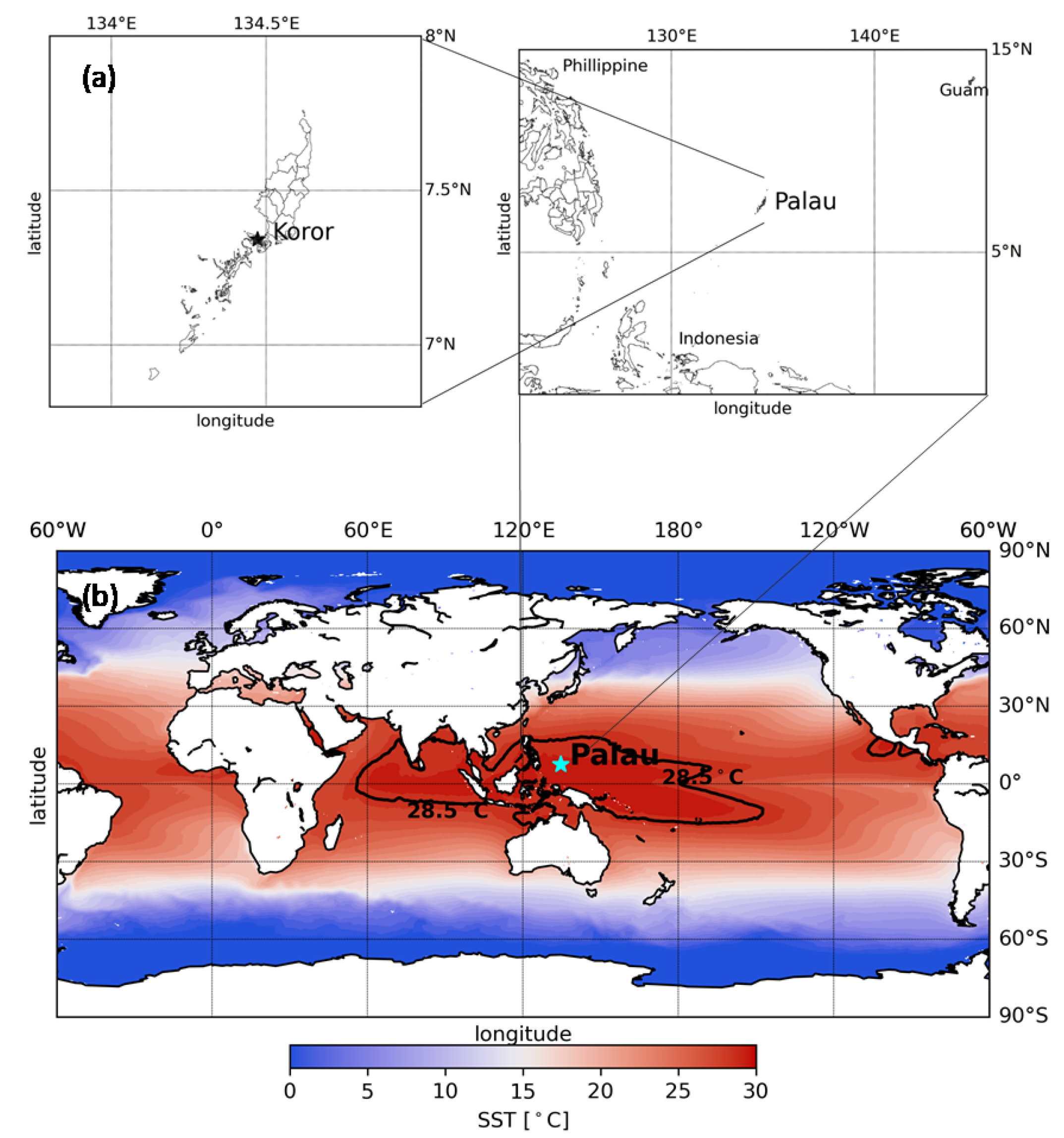
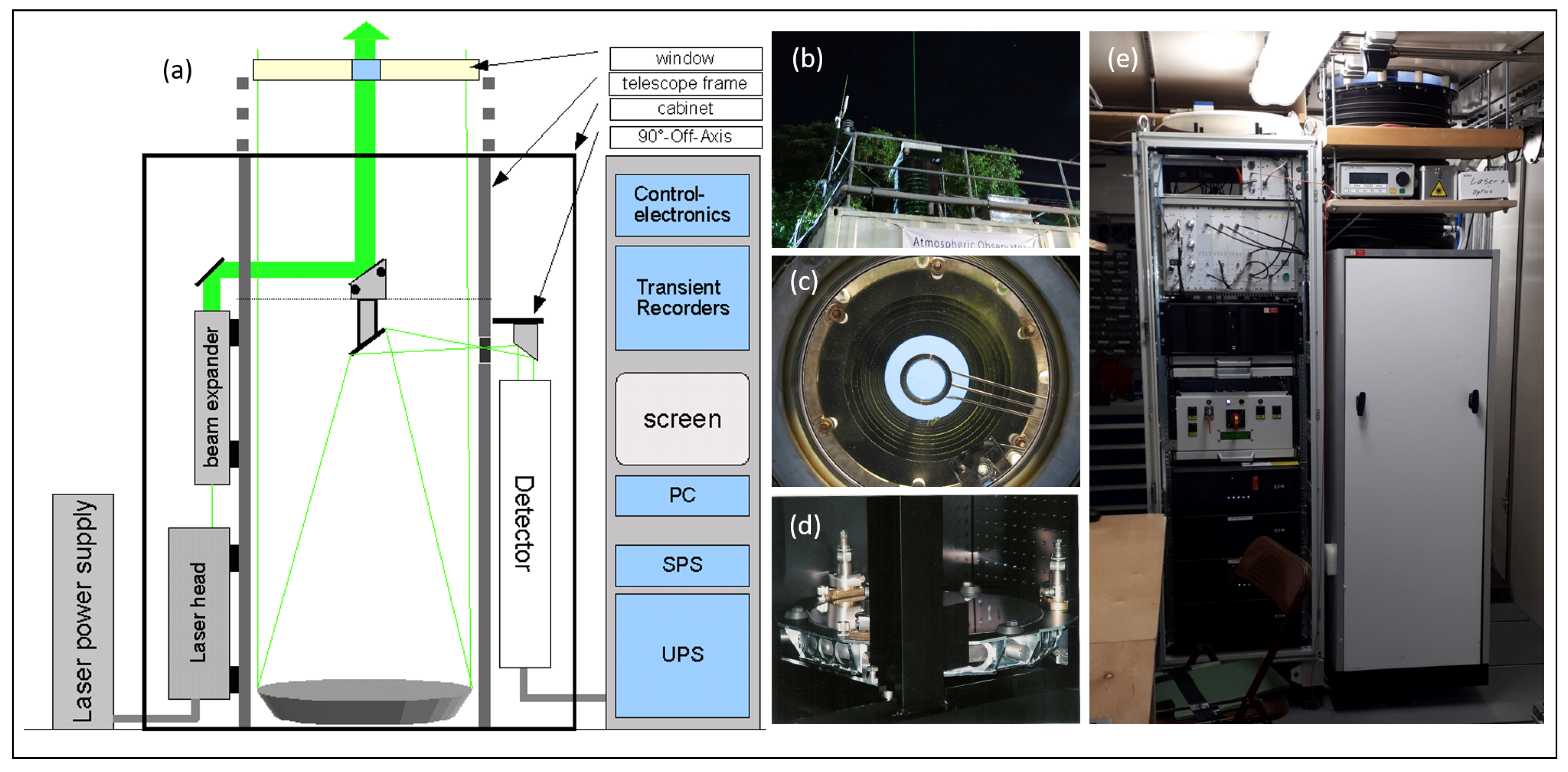
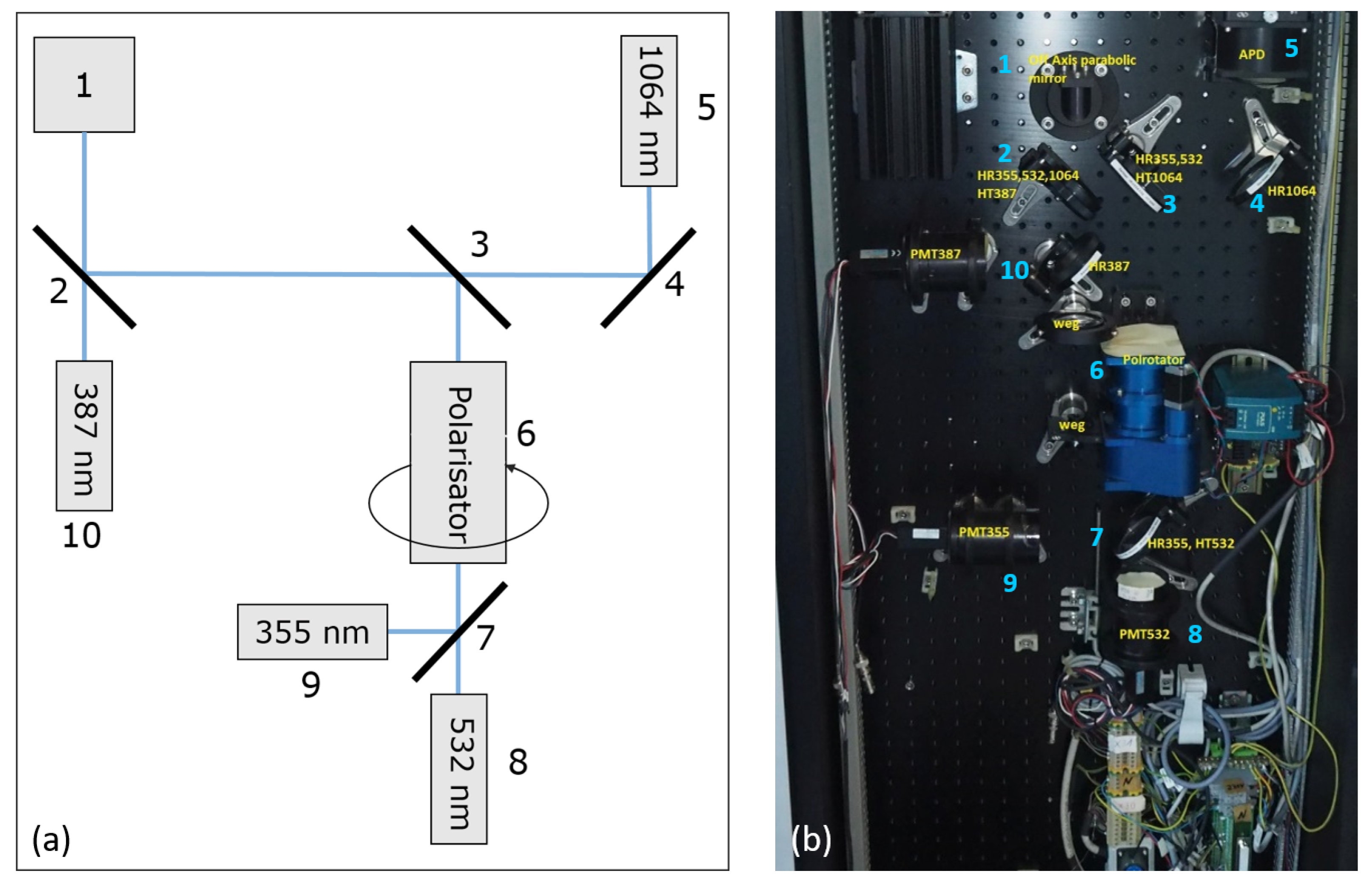

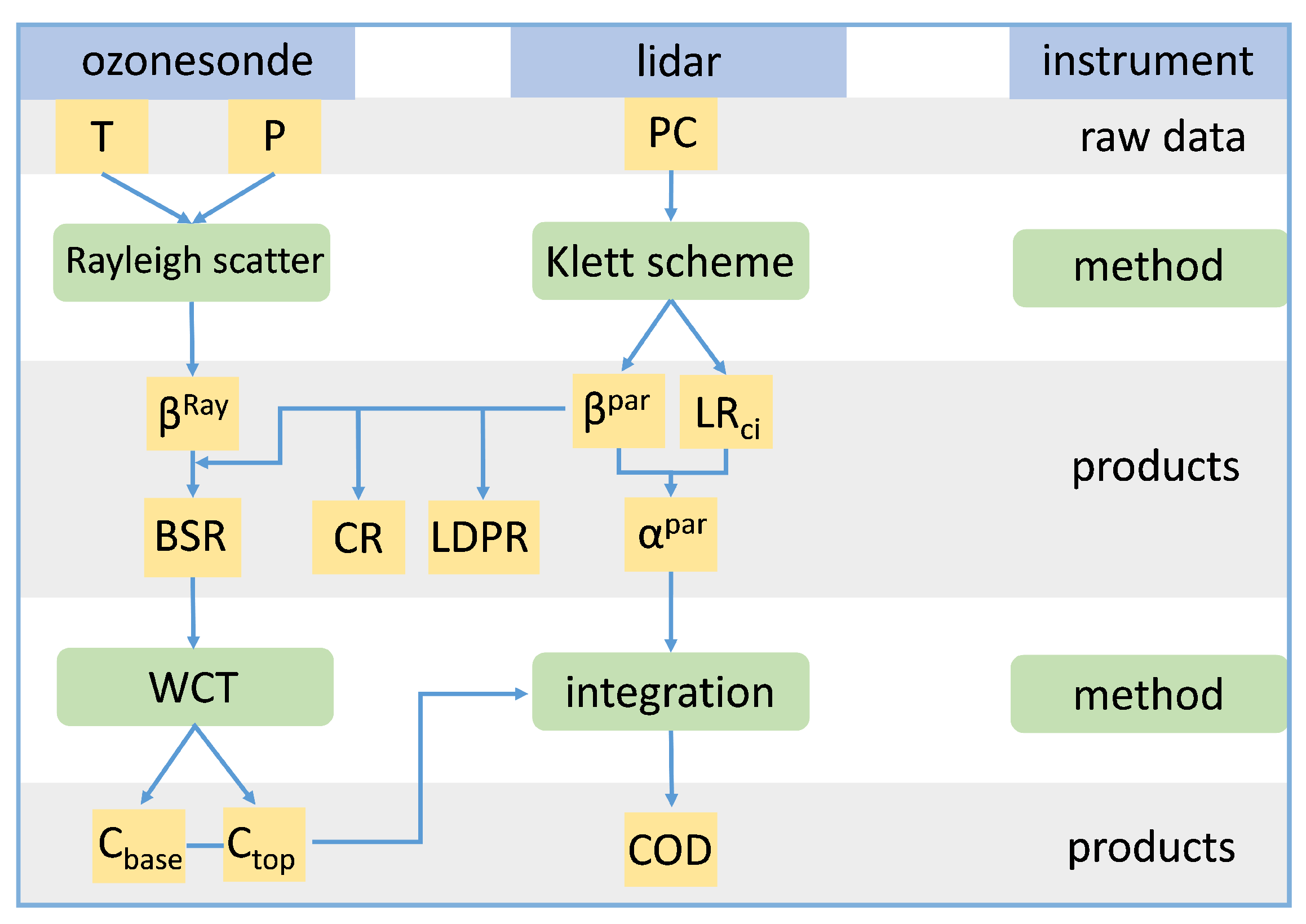
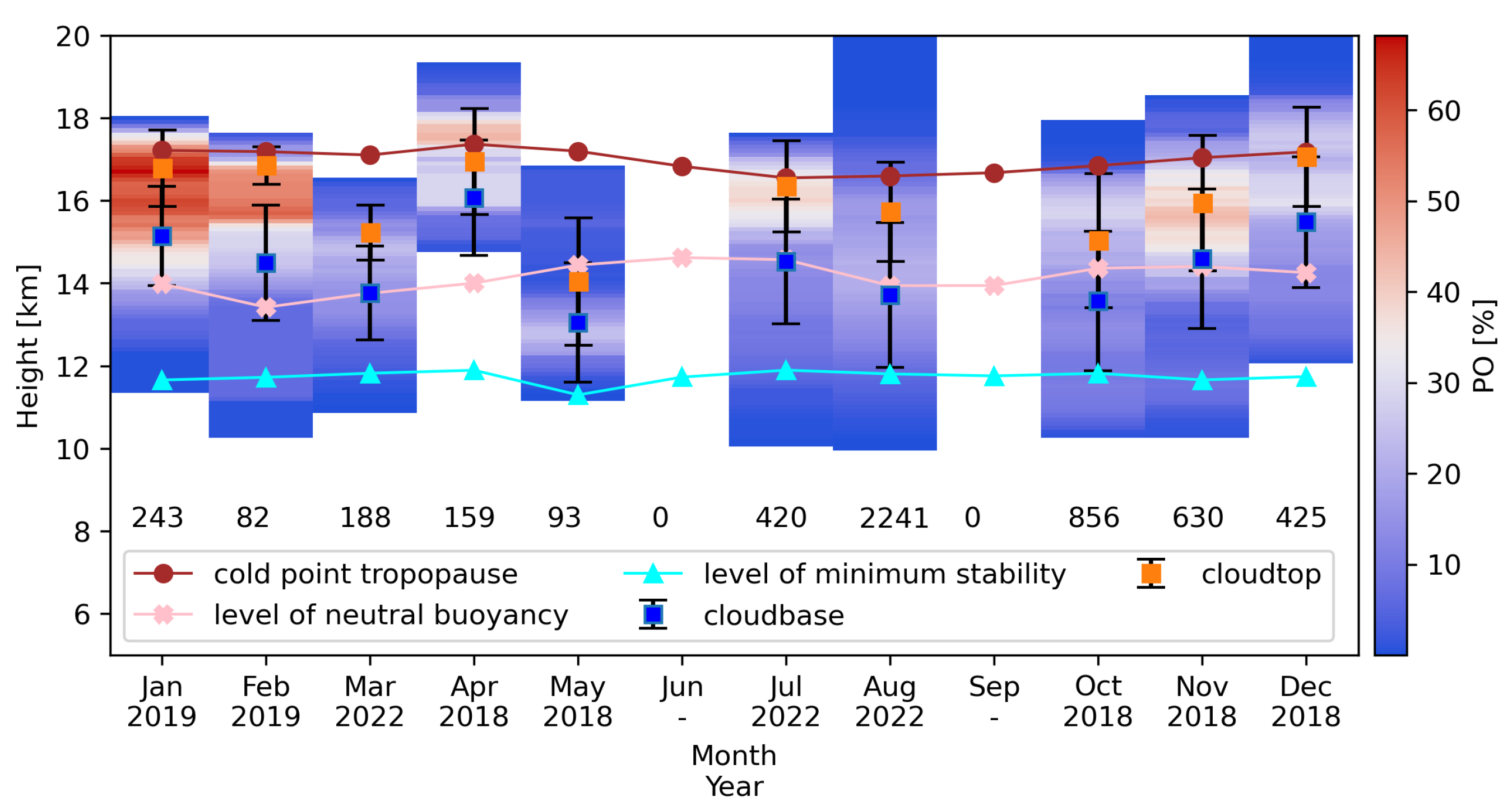
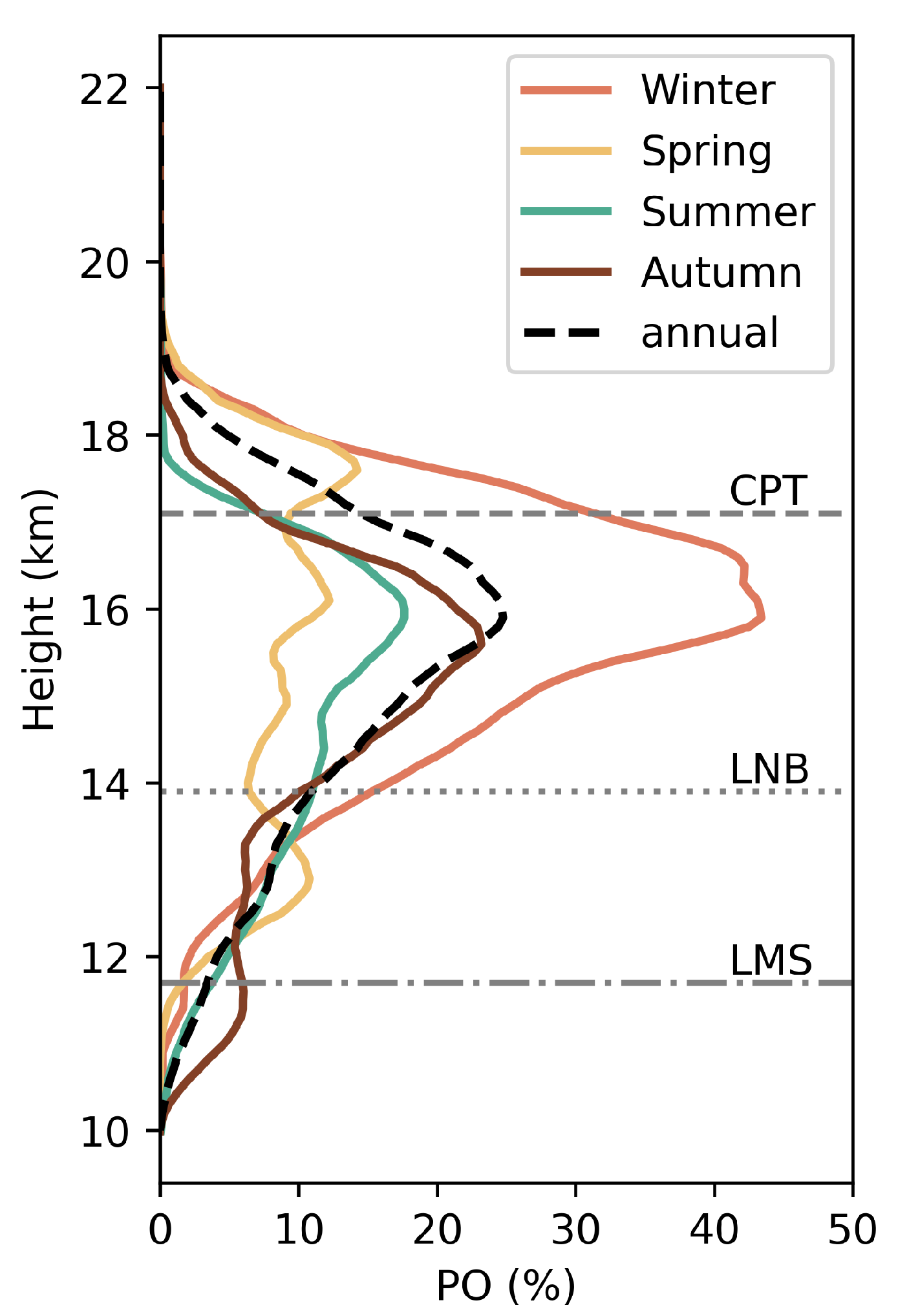



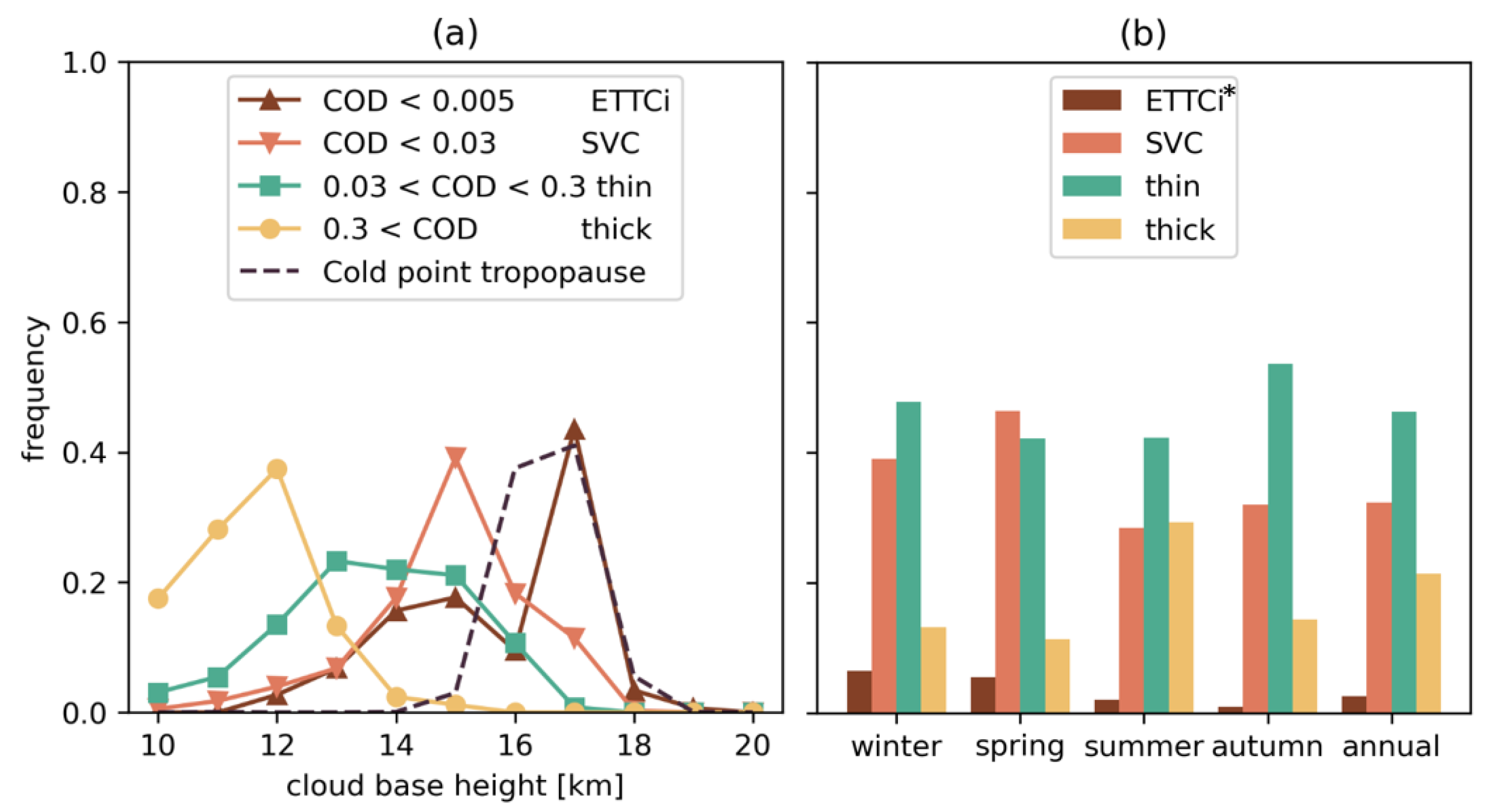
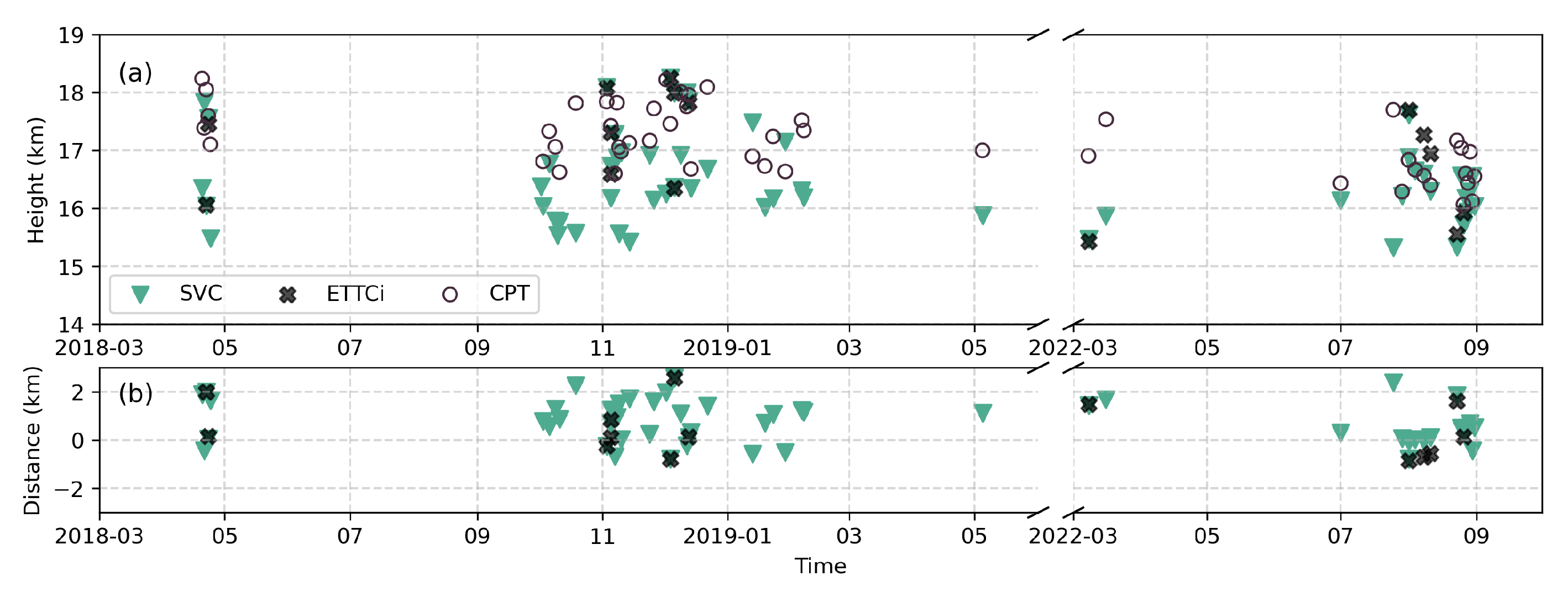
| Year | Month | Season |
|---|---|---|
| 2018 | December | Winter |
| 2018 | January | |
| 2019 | February | |
| 2022 | March | Spring |
| 2018 | April | |
| 2018 | May | |
| 2022 | July | Summer |
| 2022 | August | |
| 2018 | October | Autumn |
| 2018 | November |
| Channel (nm) | Pulse Energy (mJ) | Max. Transmission |
|---|---|---|
| 1064 | 120 | 82% |
| 532 | 180 | 36% |
| 355 | 65 | 52% |
| Cirrus Properties | Annual | Winter | Spring | Summer | Autumn |
|---|---|---|---|---|---|
| Cloud base temperature (°C) | −71.7 ± 11.5 | −73.7 ± 10.9 | −67.9 ± 12.5 | −63.4 ± 13.6 | −64.5 ± 13.4 |
| Cloud top temperature (°C) | −75.9 ± 9.0 | −82.5 ± 4.8 | −71.9 ± 10.1 | −76.4 ± 6.8 | −73.9 ± 11.4 |
| Mid-cloud temperature (°C) | −70.4 ± 10.4 | −78.1 ± 7.1 | −67.9 ± 10.8 | −69.9 ± 9.0 | −69.0 ± 12.0 |
| Geometrical thickness (km) | 1.5 ± 0.9 | 1.6 ± 0.9 | 1.0 ± 0.5 | 1.9 ± 1.2 | 1.4 ± 0.7 |
| Cloud base height (km) | 14.1 ± 1.7 | 15.3 ± 1.4 | 14.0 ± 1.7 | 13.9 ± 1.8 | 14.0 ± 1.7 |
| Cloud top height (km) | 15.8± 1.4 | 16.9 ± 1.0 | 15.1 ± 1.6 | 15.8 ± 1.2 | 15.4 ± 1.6 |
| COD | 0.25 ± 0.45 | 0.17 ± 0.33 | 0.15 ± 0.30 | 0.33 ± 0.53 | 0.19 ± 0.35 |
| ETTCi */SVC/thin/thick (%) | 1.6/32/46/22 | 6.2/39/47/14 | 2.0/46/43/11 | 0.7/28/43/29 | 0.6/32/54/14 |
| Color ratio (355/532) | 1.6 ± 0.5 | 1.5 ± 0.5 | 1.6 ± 0.4 | 1.1 ± 0.1 | 1.6 ± 0.5 |
| LDPR (%) | 31 ± 19 | 34 ± 22 | 25 ± 16 | 36 ± 18 | 24 ± 16 |
| Site | (km) | (km) | GT (km) | Temperature (°C) | Reference |
|---|---|---|---|---|---|
| Koror (7.3°N, 134.5°E) | 14.1 ± 1.7 | 15.8 ± 1.4 | 1.5 ± 0.9 | −74 ± 10 | this study |
| Gwal Pahari (28.43°N, 77.15°E) | 9.0 ± 1.5 | 10.6 ± 1.8 | 1.5 ± 0.7 | −33 ± 6 | [53] |
| Elandsfontein (26.25°S, 29.43°E) | 9.2 ± 0.8 | 10.8 ± 0.9 | 1.6 ± 0.7 | −34 ± 5 | |
| Chung-Li (24.58°N, 121.10°E) | 12.3 ± 2.2 | 14.4 ± 1.7 | 1.5 ± 0.7 | - | [34] |
| Gadanki (13.5°N, 79.2°E) | 13.0 ± 2.2 | 15.3 ± 2.0 | 2.3 ± 1.3 | −65 ± 12 | [35] |
| Hulule (4.1°N, 73.3°E) | 11.9 ± 1.6 | 13.7 ± 1.4 | 1.8 ± 1.0 | −58 ± 11 | [59] |
| Amazonia (2.9°S, 59.9°W) | 12.9 ± 2.2 | 14.3 ± 1.9 | 1.4 ± 1.1 | −60 ± 15 | [60] |
| Nauru Island (0.5°S, 166.9°E) | - | 16.5–17.0 | - | - | [17] |
| Tropics ± 30° * | - | 14.3 ± 1.7 | 0.6 ± 0.2 | −66 ± 10 | [61] |
Disclaimer/Publisher’s Note: The statements, opinions and data contained in all publications are solely those of the individual author(s) and contributor(s) and not of MDPI and/or the editor(s). MDPI and/or the editor(s) disclaim responsibility for any injury to people or property resulting from any ideas, methods, instructions or products referred to in the content. |
© 2024 by the authors. Licensee MDPI, Basel, Switzerland. This article is an open access article distributed under the terms and conditions of the Creative Commons Attribution (CC BY) license (https://creativecommons.org/licenses/by/4.0/).
Share and Cite
Sun, X.; Ritter, C.; Müller, K.; Palm, M.; Ji, D.; Ruhe, W.; Beninga, I.; Patris, S.; Notholt, J. Properties of Cirrus Cloud Observed over Koror, Palau (7.3°N, 134.5°E), in Tropical Western Pacific Region. Remote Sens. 2024, 16, 1448. https://doi.org/10.3390/rs16081448
Sun X, Ritter C, Müller K, Palm M, Ji D, Ruhe W, Beninga I, Patris S, Notholt J. Properties of Cirrus Cloud Observed over Koror, Palau (7.3°N, 134.5°E), in Tropical Western Pacific Region. Remote Sensing. 2024; 16(8):1448. https://doi.org/10.3390/rs16081448
Chicago/Turabian StyleSun, Xiaoyu, Christoph Ritter, Katrin Müller, Mathias Palm, Denghui Ji, Wilfried Ruhe, Ingo Beninga, Sharon Patris, and Justus Notholt. 2024. "Properties of Cirrus Cloud Observed over Koror, Palau (7.3°N, 134.5°E), in Tropical Western Pacific Region" Remote Sensing 16, no. 8: 1448. https://doi.org/10.3390/rs16081448





